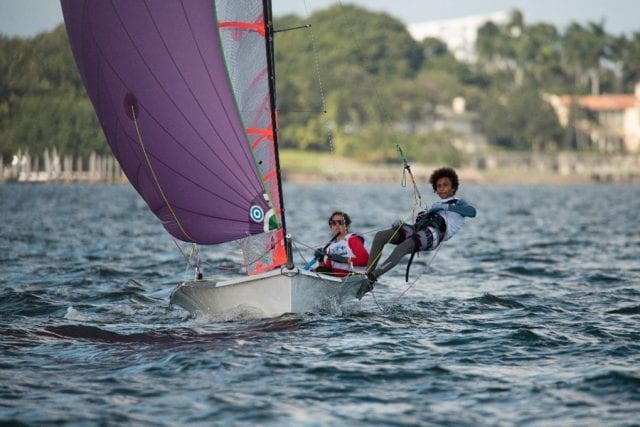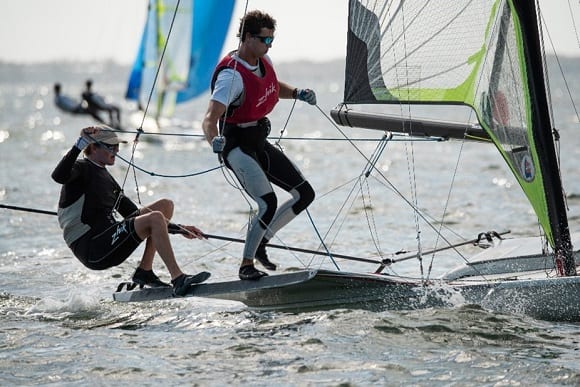
By Philip Muller, Head Coach & Founder, 2NINER / Skiff Generation
What is 29er sailing? What is the attraction for youth sailors and why do they migrate away from traditional ‘boxy’ youth boats or other traditional classes into the skiff?
The 29er is the small version of the Olympic class men’s 49er and women’s 49erFX. It is a two-person skiff where the crew trapezes while the skipper hikes from the wing. The low-profile hull is lightweight (185 lbs) with an oversized sail plan, making the boat very sensitive and powered up for the crew.
The 29er is tippy and more difficult to sail than traditional dinghies, but as with all things, the harder the challenge, the more opportunity for growth.
There are so many attractive qualities to newer high-performance classes like the 29er over traditional dinghies with white sails. The speed of the boat is thrilling and adds a new dynamic to racing that many youth sailors have yet to experience on the water.
Apparent wind racing is different from displacement dinghy racing and learning the new game is fun and challenging. Most sailors who seek out the 29er are attracted to the performance of the boat. Speed brings them in, not just in a straight line downwind at 20 mph but the pace of quick decision making, and tactical moments makes the racing thrilling. This attraction brings in a lot of sailors who did not follow the typical path of youth sailing through Optis. Teens who find sailing in the Laser or 420 not particularly engaging make the jump to the 29er because of the fun and physical challenge.
One unique feature in skiff sailing is that the crew trims the mainsheet from the trapeze, elevating the role of the crew compared to that in traditional doublehanded boats. The skipper and crew are on equal footing and developing a strong team that works well together is key. Teamwork makes the dreamwork.
For anyone who grew “too quickly” for the Opti and spent too many light air races stuck in a little ball, stretching out on the wire of the 29er feels good. The boat is so sensitive and responsive that the instant feedback of power is exhilarating.
The 29er is an open class, so pairs of sailors can mix and match so any combo of single or mixed gender works and the class has no age limit. Our big events and world championships are open. This means sailors can represent their country on the world stage with our team at 2NINER once they are ready. For anyone who just missed out on Opti worlds, this is an opportunity to test your metal with the best.
Why “The Skiff Generation”?
Though the learning curve is steep, high-performance classes welcome new sailors into a supportive environment that is more akin to top level racing. Skiff culture is all about sharing best practices across the fleet. We like to say, “there’s no secret recipe.” Sailors of all stripes work together to raise the bar. It is a more inclusive, national effort rather than club versus club rivalry. We believe a rising tide lifts all boats. As a fleet, we develop bonds and friendships where sailors can share knowledge and information. What this means is that on the race track it all comes down to the athletes’ performance and execution.
That is what inspired us to launch the Skiff Generation Grand Prix Series, the mixing of youth and elite Olympic-class racers together.
The Skiff Generation Grand Prix, a brand new training platform for U.S. high-performance sailing development, features three skiff classes in one regatta: the 49er, 49er FX, and the 29er. 29er sailors get to share the race course with top American sailors in their own progression towards the Olympic-class boats.
My personal sailing history is unique. I was lucky to grow up with an Olympian as my neighbor and coach. That proximity gave me the opportunity to train with him and his training partners, all of whom were the best sailors in the world at the time. My development in the sport was exponential. I learned at a young age from those at the top of our sport. This format of pushing together youth and elite is part of my personal story and the concept of Skiff Generation Grand Prix is to do the same.
We have put together an ambitious schedule of hosting six events throughout the winter in Miami. We are two events in and the feedback has been overwhelmingly positive. Sailors of all ages love getting together to race. The Olympic-class group enjoys seeing the next generation of youth, and our youth athletes get to walk up to and ask the pros questions right in the boat park. It is a very cool experience.
How does getting involved in skiff sailing as a youth sailor help them transition into the adult world of one design sailing?
The skills we focus on and develop in high-performance racing embolden sailors to succeed in sport and life. The speed and pace of racing forces you to be forward thinking. I spent a lot of time as a youth sailor talking to myself, frustrated while slogging around the course. Learning to focus on a solution rather than the problem is what high-performance racing is all about. Something is going to go wrong, and it is up to you to put the fire out and get back to racing. If that is not a metaphor for life I don’t know what is.
As far as life opportunities, high-performance sailing opens doors. Our role at 2NINER is to develop and connect talent to a larger network of experts within our sport. Whatever a sailor’s goal or interest, we support them and introduce them to our larger sailing family. Graduates of our youth program are current Ivy-League collegiate athletes, Olympic-class campaigners, professional sailors, and World Champions.
What does the future hold for these youth sailors as they grow up? Is the vision that they stay in skiffs or foiling boats? Or are they learning skills from skiffs that can be transferred across classes?
The 29er class is a direct pipeline to next level sailing. Crews develop explosive strength, coordinated accuracy and precision hand and footwork. Sail trim is an ever-moving target in apparent wind sailing, it takes a lot of focused training to manage so many things in order to constantly put the sails in the sweet spot.
Skippers develop a heightened sense of feel and awareness of performance of the boat. The skipper’s ability to put the boat in the right spot and remain calm, cool and collected under pressure is a skill every human needs.
Communication between the helm and crew is everything. To be in harmony with the boat and each other, and then scan the water to make split second tactical decisions requires a depth of skill that prepares athletes for any challenge our sport has to offer.
So, what does the future hold?
The future is fast. After practice we go foiling or kiting for fun. These skills require dynamic athleticism learned by trapezing, hoisting and trimming while on the knife’s edge prepares athletes for the next level.
Skills of teamwork, communication, and discipline are welcomed universally. Take a quick scan of the pro circuit Etchells, Melges, and J fleets and you will find high performance sailors scattered throughout.
If you want to get involved, find us at 2NINER.org. We offer year-round programming in Miami. And in 2021 we will host a series of clinics around the country. We are also planning to take the Skiff Generation Grand Prix on the road, coming to a venue near you. It is our privilege to share skiff sailing with those who are up to the task.
Please visit One Design Central for more one design sailing resources and information.
A Message from 2NINER
We at 2NINER want to extend our deepest thanks to title sponsor, The Kolter Group, for their support and commitment to making this dream a reality. We could never have attempted this endeavor without their support. We also thank our supporting sponsors 49er.ca, Zig Travel, iUniforms, and Sailing Performance Training.
About the Author
Phil Muller is the head coach and founder of 2NINER, a high-performance sailing program based in Miami, US Sailing Olympic Development Program and Youth Worlds team coach, and organizer of the Skiff Generation Grand Prix.
*All photos courtesy of 2NINER



